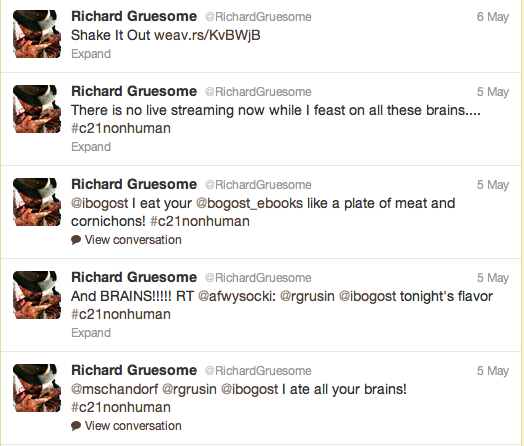
By Charlotte Frost
Within the busy The Nonhuman Turn conference Twitter stream (which was marked by the #c21nonhuman hashtag) there loomed a rather apt entity: a distinctively nonhuman interlocutor by the name of Richard Gruesome. This zombie-esque character, apparently inspired by C21 director Richard Grusin (they both wear the same hat), offered regular tweets that riffed off the conference theme and Grusin’s work. Indeed, Gruesome’s Twitter profile states that before this so-called nonhuman turn he ‘[m]ay have been Richard Grusin, but [is] now just the ramblings of his half-eaten bot-brain’. Building on this nonhuman motif, he appears to follow a collection of objects, animals, dead or fictitious characters and even their dead – as in inactive – Twitter accounts. His blog (linked to from the Twitter profile) contains the fuller content of some of his tweets, as well as a chat function so you can talk to him, and a curious button suggesting you might also clone him. During the conference some people cautiously ‘retweeted’ a few of Gruesome’s tweets, a handful of well-known attendees followed his Twitter account, and many wondered who had created this nonhuman automated ‘twitter bot’. Well, the creator – it might be more precise to say co-creator – of Richard Gruesome was me.
 The impulse behind cultivating this avatar links to the work I have been doing here. As the Provost International Post-Doctoral Fellow here at C21, I have been responding to the question: what is twenty first century studies? For me, contemporary scholarship is about a changing academy. There is an increasing amount of inter- or transdisciplinarity which sees the objectives and practices of once discrete disciplines combined to new effect. There are new questions arising out of these blurred disciplinary boundaries and the politics of the contemporary moment. With digital communication technologies there are also emerging modes of production and ‘publication’ and, running parallel to this, a focus on a more makerly approach to academic enquiry. Referred to variously as ‘edu-makers’, ‘multimodal’ or ‘transmedia’ scholars, a good number of media theorists are investigating how we can transcend and augment academic writing by working with different media and exploring in many different directions at once. I am particularly interested in the relationship between the form and content of the art history book and by working critically across media to ask different questions about art contextual scholarship. As part of this practice-based research (see Arts Future Book), I often make the projects, situations and multimodal critical objects I need to advance my thinking.
The impulse behind cultivating this avatar links to the work I have been doing here. As the Provost International Post-Doctoral Fellow here at C21, I have been responding to the question: what is twenty first century studies? For me, contemporary scholarship is about a changing academy. There is an increasing amount of inter- or transdisciplinarity which sees the objectives and practices of once discrete disciplines combined to new effect. There are new questions arising out of these blurred disciplinary boundaries and the politics of the contemporary moment. With digital communication technologies there are also emerging modes of production and ‘publication’ and, running parallel to this, a focus on a more makerly approach to academic enquiry. Referred to variously as ‘edu-makers’, ‘multimodal’ or ‘transmedia’ scholars, a good number of media theorists are investigating how we can transcend and augment academic writing by working with different media and exploring in many different directions at once. I am particularly interested in the relationship between the form and content of the art history book and by working critically across media to ask different questions about art contextual scholarship. As part of this practice-based research (see Arts Future Book), I often make the projects, situations and multimodal critical objects I need to advance my thinking.
At the simplest level, I made the Richard Gruesome bot as a playful ruse. Richard Grusin has been my director for the past year, and as so many well-known people find themselves with tribute bots, I thought it would be fun to make one for my boss (a parting mischief perhaps). Yet I also wanted to make something that would allow me to confront quite literally the concept of the nonhuman turn – something present in much of my work but not explored in quite these terms. Obviously it was apt to situate a nonhuman in the Twitter stream itself, but in fleshing-out Gruesome’s online persona I would be able to curate a light-hearted but no less relevant collection of ideas. For example, making him follow animals on Twitter allowed me to reference animal studies and notions of affect and anthropomorphism, while fashioning him as the undead meant I could reference and consider the popular zombie metaphor hastily propagating in both media studies and discussions on the future of the academy.
Richard Gruesome is not your average bot set to retweet or remix existing tweets and my plans for reflection did not end with the topic of the conference. In order to create Richard Gruesome I used a website called Weavrs, which makes artificial social media users. Weavrs trawls the internet for material relating to preselected keywords. It then posts content as though blogged by the fictitious characters to reflect their supposed thoughts, feelings and activities. To assemble Gruesome’s persona I therefore had to feed Weavrs with a set of words designed to somehow conjure up a version of the real Grusin. This would not be too difficult because as an academic he is known most widely via words. In fact, like many academics, he is known for a very particular set of words which denote his major theories and publications. In Grusin’s case these include ‘remediation’ and ‘premediation’, which I plugged into the site alongside others such as ‘theory’, ‘affect’, ‘literature’ and some selected to express mood – I suggested he might be feeling somewhat ‘critical’ or ‘conferencey’. Gruesome’s blog quickly came to (artificial) life with a speech bubble over his image announcing various combinations of welcoming text including: ‘Hi. I’m an English speaking 120 year old object and I’m feeling Conferencey. Do you like remediation and nonhuman images?’. And I watched for this artificial intelligence to post to its blog, tweet and even make Foursquare-style check-ins at locations across Milwaukee including the C21 building itself. You see, this project was not just set up to explore ideas about the nonhuman turn, it was also intended to problematise academic practices. We often use the work of other academics to develop our own arguments, but could I develop a scholar to think a bit more metacognitively about what we are and what we do?
With Gruesome up and running I could now reflect on the form of the Nonhuman Turn conference and of academic work more generally. I started to think about the way we build ourselves out of rhetoric; like Gruesome, we’re humans made of text. Currently I am reading China Mieville’s Embassytown and am enthralled with the idea that one of the characters is part of an alien metaphor. She is both herself and, thanks to one moment of substitute acting, a foreign figure of speech. When we speak at conferences we enact some sort of in-person publication of our work, we become it, or we at least become synonymous with it. My Twitter bot serves as an excellent reminder of the sinews connecting a corpus and its human maker. Though what I did not know when I started this was that several of the plenary speakers at the conference (and many others in the ‘breakout sessions’) would choose to embody their work by staging extremely performative presentations. Further than that, two speakers in particular were to offer quite exaggerated self/work metaphors – one styling himself as a carpenter of anti-meaning, the other some kind of beat-beelzebub of multi-meaning.
Their desire to affect us with such rhetorical styling made me also think about the afterlife of academic writing. Often we treat academic text like an undead body of (once live) thoughts allowed to roam (relatively) freely and be cloned or replicated in works that synthesize and cite the original (host) text. In a way, all of us become non-humans on twitter, ravenously feasting on and regurgitating tweets. Twitter is yet another – if not yet quite legitimate – way of mobilizing zombie-idea-armies. By making Gruesome tweet: ‘forget affect, I’m here to infect’ I used my ghost in the machine to emphasize how sometimes the push for outreach and impact turns complex theory into highly marketable (and or retweetable) sound-bites. During the conference I was acutely aware of the ways we cue our theoretical fidelities through careful phrases. And I also noticed how some speakers had cloned Grusin’s ideas without realizing (which made up for the fact nobody had discovered the ‘clone me’ button on Gruesome’s blog to make their own version of the character).
During our last fellows meeting (where I ‘outed’ myself as Gruesome’s maker) we had a rich debate about the way we use philosophy and critical theory. My colleague Rebekah Sheldon reminded us of a statement by Gilles Deleuze describing how we might put an author’s work to productive use:
“But what really helped me come off at the time was, I believe, to view the history of philosophy as a screwing process or, what amounts to the same thing, an immaculate conception. I would imagine myself approaching the author from behind, and making him a child, who would indeed be his and would, nevertheless, be monstrous. That the child would be his was very important because the author had to say, in effect, everything I made him say. But that the child be monstrous was also a requisite because it was necessary to go through all kinds of decenterings, slidings, splittings, secret discharges which have given me much pleasure.”
(Deleuze, Gilles. “I Have Nothing to Admit.” Semiotexte. 2.3. Tr. Janis Forman, 1977, p.117)
I would argue that academic work is less a form of birthing than a monstrous puppetry. We reanimate sometimes dead sometimes living scholars in our own work and make them co-perform the theories and practices we are intellectually invested in. A multimodal philosophical project like Richard Gruesome makes this puppetry even clearer. It works towards a more holistic investigation of academic work by coalescing an analysis of form and content, concept and approach. To put this another way, in a move that is dead on cultural and theoretical trend, it is a way to kill your boss and (intellectually) feed off the results.
Acknowledgements:
I would like to thank my bot-advisor and collaborative partner in all things critical-fleshly, Rob Myers; my Director Richard Grusin for his support this year and for being such a great sport when he found out what I had done; Jesse Stommel for helping puppeteer this post and for all his collaborative magic; and all my fellow fellows whose brains I have fed off (with relish!) this past year.
[Charlotte Frost is the C21 Provost International Post-Doctoral Fellow. She’s been busy during her time at the center – blogging, attending conferences, giving keynotes, launching a book series, and continuing her research on the intersections between art history and digital studies]


